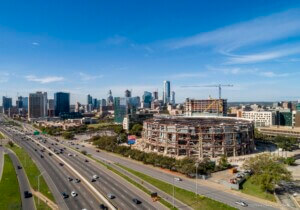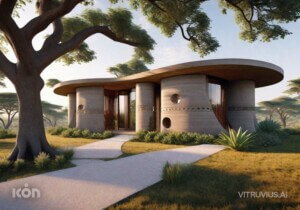On October 10, the two-day South by Southwest (SXSW) Eco Conference kicked off in Austin, Texas. Igor Siddiqui and Nerea Feliz, professors at the University of Texas at Austin School of Architecture, were asked to design the stage backdrops for this year’s event. The design brief specified eight different, but interrelated, stage backdrops for the conference, ranging in width from 12 to 30 feet and offering a “striking visual presence that highlights innovation.”
Together, Siddiqui and Feliz explored issues of serial variation, digitally derived patterning, and robotic painting. The result was Serriform. Drawing on Ettore Sottsass’s 1992 Adesso Peró bookcase, Serriform gets its name from the serrated edges of its columns.
“Digital technologies have transformed the logic of mass production by allowing repetitive processes to produce variation, meaning that components, objects, and patterns produced in a series no longer all have to be the same,” said Siddiqui. “Our project was designed with such capabilities in mind.”
For example, Siddiqui continued, the columns forming the principal structure for the stage backdrops feature a range of different geometric profiles, while still belonging to the same “family.” “This was achieved using a parametric script in the design process,” he said. “Because the columns were fabricated digitally [using CNC machinery], it was as efficient to produce the series with such variation as it would have been had they all been identical.”
A Kuka Robotics KR60 robotic arm spray-painted the pattern on the panels while a script in algorithmic modeling editor Grasshopper was used to facilitate variation in the paint application. During this process, the script remained the same, but the variables within it changed in order to take into account materiality, fabrication, assembly, and use. “We were amazed by the idiosyncratic nature of each mark—none is the same even if the script is repeated over and over again,” said Siddiqui. “This allowed us to make the kinds of painted marks that would have been difficult, if not impossible, to achieve through any available mechanical or manual means.”
Siddiqui and Feliz intend for Serriform to be used beyond the SXSW conference. “The challenge of temporary installations like this is that they are only useful for a short period in time,” Siddiqui said. “A plan for its after-use was very important to us, so the whole installation is actually designed to serve as a shelving and partition system afterwards.” (According to Siddiqui, a Serriform 2.0 is on the way.) “We looked at iconic bookshelf designs, seeking examples where their sculptural qualities transcended function,” he continued. “Adesso Peró gave us some good clues, while allowing us to come up with a more variable version tailored to the digital era. Sottsass’s design is still all based on the repetition of the same dimension and form, and today we can do so much more! While his bookcase is a piece of furniture, we think of work as architecture. In this way, the H-profile columns (like that of steel members) are decidedly tectonic in nature and open to other spatial applications. We are continuing to work on this project by designing new scenarios for how the columns and panels can be used as shelving and partitions, and, unlike their role as backdrops, arranged in space in a more three-dimensional way.”










